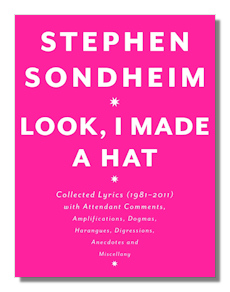
The Internet's Premier Classical Music Source
Related Links
-
Introduction
Acoustics
Ballet
Biographies
Chamber Music
Composers & Composition
Conducting
Criticism & Commentary
Discographies & CD Guides
Fiction
History
Humor
Illustrations & Photos
Instrumental
Lieder
Music Appreciation
Music Education
Music Industry
Music and the Mind
Opera
Orchestration
Reference Works
Scores
Thematic Indices
Theory & Analysis
Vocal Technique
Search Amazon
Recommended Links
Site News
 Book Review
Book Review
Look, I Made a Hat

Collected Lyrics (1981-2011)
Attendant Comments, Amplifications, Dogmas, Harangues, Digressions, Anecdotes and Miscellany
Stephen Sondheim
New York: Alfred A. Knopf. 2011. 480 pages.
ISBN-10: 030759341X
ISBN-13: 978-0307593412
Summary for the Busy Executive: More from the pro.
Sondheim's first volume of lyrics, Finishing the Hat, discussed his shows and lyrics up to Merrily We Roll Along. The title came from the later Sundays in the Park with George, ironically not discussed. The second volume includes everything later, as well as the lyrics for projects never realized, special lyrics for "occasions," and lyrics for movies and television.
Sondheim, widely regarded as the best and most innovative Broadway composer of his generation, fortunately went beyond merely collecting lyrics and retelling amusing show-biz anecdotes, although he did both. Finishing the Hat showed what he thinks of when he writes a lyric, not only in terms of the craft of verse but in the context of the immediate dramatic situation. This second volume concentrates on how lyrics contribute to the structure of a complete show. Sondheim assumes that you have read the earlier volume. He thinks of both works as one book, split only because he didn't want to produce a work too tiring to lift. He tries not to repeat himself. Therefore, he gives you a lot less about verse technique, except in passing. The remarks on other lyricists come down to little more than individual paragraphs in two brief essays. He has moved on. In a way, this book will probably stir less controversy than the first. There are no diatribes against cherished writers, although it's hardly a bouquet of posies. The long essays address more general topics: criticism vs. reviewing, the value of awards (rather cynical and realistic, considering that you can't accuse Sondheim of sour grapes), and so on.
The real meat of the book, however, lies in Sondheim's exposition of how Road Show came into being. It tells the tale of brothers Wilson and Addison Mizner, two go-getters on the make – Wilson as a promoter and Addison as an architect and interior designer. It began as the show Wise Guys, which went through two versions (1998, 1999) but never made it to Broadway. Sondheim and his collaborator, John Weidman, were dissatisfied. Despite stuff they liked, the show just seemed to go by. In 2003, they finished the new, improved version, now called Bounce. Hal Prince, the new director, decided that the show should talk about American resilience and hustle. New characters, including a female love interest, were inserted. Still, the show lost air at major points. In many ways it sprawled more and spawned more problems than the version it tried to fix. This led, in 2008, to Road Show, which emphasized the relationship between the Mizner brothers. Sondheim and Weidman realized (with the help of the Public Theater's Oskar Eustis) that they should have focused on those two all along. To pick up the narrative pace (at director John Doyle's insistence), they reconceived the book from two acts to one and finally pronounced themselves satisfied. According to Sondheim's appendix, the show that took ten years to write ran for ten days at the Public Theater in New York. There's a lot more, of course, fascinating to those interested in large-scale dramatic problems and "play-doctoring." Actually, Sondheim writes so entertainingly and intelligently, it would probably grab someone other than intellectual stage-boy Johnnies. What stayed with me was an appreciation of the amount of effort and work it takes many intelligent people to put on a Sondheim show.
In addition to the lyrics, annotations, and tangents, the book contains the histories of first runs of the shows from Sunday in the Park on and a list of performers and major contributors. Shows like The Evening Primrose for TV, left out of the first volume, alternate lyrics that Sondheim still likes, stuff for friends' birthdays, projects that died a-borning, tributes, and apprentice work have their own sections. There's a discography, a good general index, as well as an index of Sondheim song titles.
I think of these two volumes in the same way that I think of a Sondheim show – smart, funny, adult, and idiosyncratic. The book still weighs enough that I couldn't read for more than an hour at a time without my arms getting tired, but I always put it down, impatient with myself that I couldn't push myself further. I couldn't wait to lift it again. Sondheim warns readers at the outset that this book doesn't talk about his personal life. You'd be a fool to care.
Copyright © 2012 by Steve Schwartz.


















